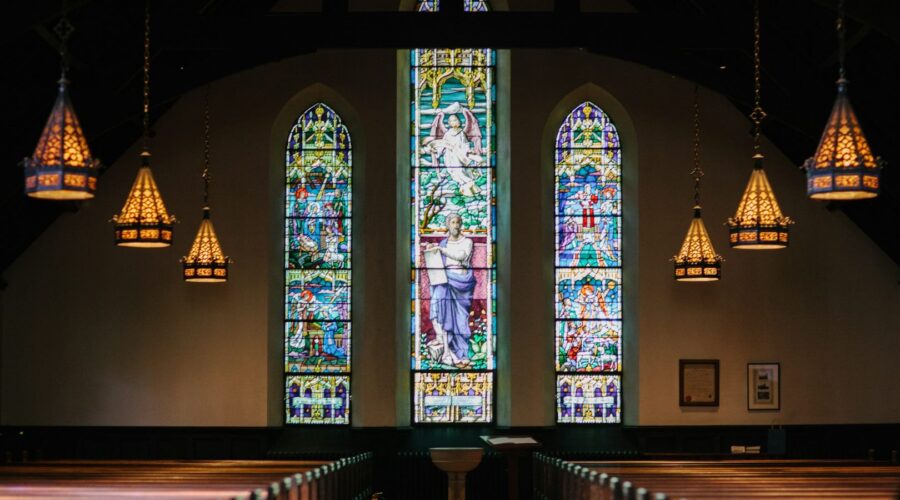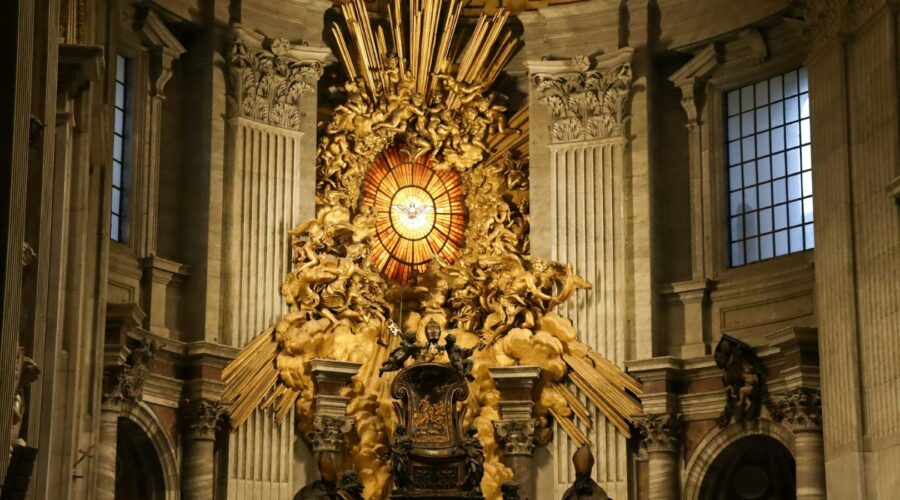Your cart is currently empty!
Month: July 2024

Dive into the Essence of the Hail Mary Prayer: A Comprehensive Guide for Catholics
“`html
Immerse yourself in a thorough examination of the Hail Mary prayer, a cornerstone of Catholic devotion. This comprehensive guide will delve into its origins, meaning, and the significant role it plays in the lives of believers.
Historical Origins of the Hail Mary Prayer
The Angelus and the Biblical Roots
The Hail Mary prayer finds its roots in the Annunciation narrative in the Gospel of Luke. The angel Gabriel’s words to Mary, “Hail, full of grace, the Lord is with thee,” (Luke 1:28) became the basis for the first part of the prayer.
The second part, “Blessed art thou amongst women, and blessed is the fruit of thy womb, Jesus,” (Luke 1:42), originated from Elizabeth’s salutation to Mary during her visitation (Luke 1:42). The final part, “Holy Mary, Mother of God, pray for us sinners now and at the hour of our death,” was gradually added over time.
Liturgical Inclusion and Papal Influence
The Hail Mary prayer gained prominence in the 15th century during the reign of Pope Sixtus IV. He encouraged its recitation at the end of the Rosary, a popular Marian devotion. Over the centuries, various popes have endorsed and promoted the prayer, including Pope Pius V and Pope Gregory XIII.
Meaning and Significance of the Hail Mary Prayer
The Essence of Humility and Gratitude
The Hail Mary prayer embodies the humility of Mary, who recognized her unworthiness despite being chosen for a divine mission. In addressing her as “full of grace,” Catholics acknowledge her exceptional favor with God.
The Blessing of Mary and Jesus
By invoking Mary as “blessed,” Catholics express their recognition of her as a vessel of God’s grace and a model of virtue. The subsequent blessing of her son, Jesus, highlights the central role he plays in their faith.
A Plea for Intercession
The final line of the prayer is a petition for Mary’s intercession. Catholics believe that as the Mother of God, Mary has a special place in heaven and can intercede on their behalf. They ask her to pray for them, both in times of need and at the critical moment of death.
Praying the Hail Mary: Variations and Customs
Traditional Recitation
The traditional recitation of the Hail Mary prayer consists of the following steps:
- Sign of the Cross
- “Hail Mary, full of grace, the Lord is with thee.”
- “Blessed art thou amongst women, and blessed is the fruit of thy womb, Jesus.”
- “Holy Mary, Mother of God, pray for us sinners now and at the hour of our death.”
- Sign of the Cross
Hail Mary in the Rosary
In the Catholic Rosary, the Hail Mary prayer is recited multiple times along with an Our Father and Glory Be prayer. The standard Rosary consists of 50 Hail Marys, each accompanied by a meditation on a specific mystery from the life of Jesus or Mary.
Devotional Practices
Beyond its traditional recitation, the Hail Mary prayer is incorporated into various devotional practices. It is commonly used in the Angelus prayer, which is recited three times a day. Additionally, Catholics may choose to recite the Hail Mary as a means of personal devotion or during moments of prayer.
The Hail Mary Prayer and the Catholic Sacraments
Reconciliation and Confirmation
The Hail Mary prayer plays a significant role in the sacrament of Reconciliation, where Catholics confess their sins and seek forgiveness. The prayer is often recited as an act of contrition.
During Confirmation, the Hail Mary is invoked as a reminder of the Holy Spirit’s presence and Mary’s protection.
Liturgy and Eucharistic Adoration
In the Mass, the Hail Mary is recited during the Prayer of the Faithful, where petitions are offered for various needs.
During Eucharistic Adoration, the Hail Mary is often prayed as an expression of reverence and love for Jesus in the Eucharist.
Hail Mary: A Timeless Prayer for Catholic Devotion
For centuries, the Hail Mary prayer has held a profound place in Catholic spirituality. Its simple yet powerful words embody humility, gratitude, and a plea for Mary’s intercession. Whether recited as a standalone prayer or incorporated into liturgical practices and sacraments, the Hail Mary continues to be a cherished expression of faith and a source of comfort and strength for Catholics worldwide.
“`

The Prince of Peace: A Biblical and Historical Exploration
Introduction
The title “Prince of Peace” holds a profound significance in both biblical and historical contexts. It is a title attributed to Jesus Christ, the central figure of Christianity, and it encapsulates the core message of peace, love, and reconciliation that permeates his teachings and mission.
Biblical Origins
Prophecy of Isaiah
The concept of the Prince of Peace first emerges in the Old Testament, in the prophecy of Isaiah. Chapter 9, verse 6 reads:
“For unto us a child is born, unto us a son is given: and the government shall be upon his shoulder: and his name shall be called Wonderful, Counsellor, The mighty God, The everlasting Father, The Prince of Peace.”
This prophecy foretells the birth of a future ruler who would bring peace and stability to the world. It forms the basis of the Christian belief in Jesus as the fulfillment of this prophecy.
Visit of the Angel
The title “Prince of Peace” is further solidified in the New Testament, during the announcement of Jesus’ birth to shepherds by an angel. As recorded in Luke 2:14, the angel proclaims:
“Glory to God in the highest, and on earth peace, goodwill toward men.”
The angel’s proclamation echoes the prophecy of Isaiah, identifying Jesus as the bringer of peace on earth.
Historical Significance
The title “Prince of Peace” has also been used throughout history to describe individuals who have made significant contributions to the cause of peace and reconciliation.
Mahatma Gandhi
Mahatma Gandhi, the revered Indian independence leader, was widely known as the “Prince of Peace.” He advocated for nonviolent resistance and played a crucial role in India’s peaceful transition to independence from British rule.
Salahuddin Ayyubi
Salahuddin Ayyubi, also known as Saladin, was a Muslim sultan who ruled over Syria and Egypt in the 12th century. Despite his military victories, he was known for his tolerance and respect towards his Christian and Jewish subjects.
Attributes and Impact
Messenger of Peace and Love
The Prince of Peace represents a message of peace, love, and reconciliation. Through his teachings, Jesus emphasized the importance of loving one’s enemies and turning the other cheek. He taught that true peace can only be achieved through forgiveness and compassion.
Example of Peace
Jesus’ life and ministry exemplified the principles of peace. He lived a life of humility, service, and sacrifice. Even when faced with persecution and violence, he remained steadfast in his message of love and forgiveness.
Influence on the World
The teachings and principles of the Prince of Peace have profoundly influenced the world. They have inspired countless individuals and movements to work towards peace, reconciliation, and justice. From the abolition of slavery to the establishment of international organizations like the United Nations, the legacy of the Prince of Peace continues to shape history.
Conclusion
The title “Prince of Peace” carries immense significance and meaning. It represents the biblical prophecy of a ruler who would bring peace and reconciliation to the world. It has also been applied historically to individuals who have dedicated their lives to the pursuit of peace. Ultimately, the message of the Prince of Peace is a timeless one that calls upon us all to embrace love, compassion, and nonviolence as the foundation for a just and peaceful world.

Unlocking the Wealth of Knowledge: Exploring the Orthodox Study Bible
In the realm of biblical study, the Orthodox Study Bible stands as a beacon of insight and understanding. Embracing the wisdom and traditions of the Eastern Orthodox Church, this comprehensive resource offers a unique and multifaceted exploration of the sacred texts.
Understanding the Orthodox Perspective
The Orthodox Study Bible is grounded in the patristic interpretation of Scripture, which emphasizes the following principles:
- Tradition: The Bible is not merely a historical document but a living revelation passed down through the Church over centuries.
- Context: Passages are interpreted within the broader context of the biblical narrative and Church teachings.
- Spirituality: The Bible is seen as a guide for spiritual growth and transformation.
Key Features of the Orthodox Study Bible
The Orthodox Study Bible is renowned for its comprehensive content and exceptional features:
Sections
- Old Testament: Includes the Septuagint (Greek version) with extensive commentary.
- New Testament: Features the original Greek text and English translation.
- Deuterocanonical Books: Incorporates additional books accepted as part of the Orthodox canon.
Annotations
More than 10,000 annotations provide historical, cultural, and theological insights:
- Explanations of biblical customs and practices
- Clarifications on complex doctrines
- References to patristic writings
Maps
Maps and charts illustrate geographical references:
- Detailed maps of biblical lands
- Chronological charts of historical events
Articles
Thought-provoking articles explore key theological themes:
- Orthodox understanding of the Trinity
- The nature of salvation
- The role of tradition in biblical interpretation
Using the Orthodox Study Bible
To effectively utilize the Orthodox Study Bible:
Contextual Reading
Read annotations in context with the biblical text to gain a deeper understanding of its meaning.
Cross-Referencing
Use the cross-reference guide to link related passages and explore different perspectives.
Devotional Use
Read the Orthodox Study Bible regularly for spiritual reflection and contemplation.
Benefits of the Orthodox Study Bible
The Orthodox Study Bible offers numerous benefits to readers of all backgrounds:
Enriched Understanding
Provides a comprehensive and authoritative understanding of biblical texts.
Spiritual Growth
Guides spiritual seekers in their journey of faith and renewal.
Ecumenical Dialogue
Facilitates dialogue and understanding between different Christian traditions.
Academic Research
Serves as a valuable resource for students and scholars of biblical studies.
Conclusion
The Orthodox Study Bible is an indispensable tool for anyone seeking a deeper understanding of the Bible. Through its rich annotations, insightful articles, and comprehensive content, it unveils the treasures of God’s Word and offers a path towards spiritual enlightenment.

Find a Catholic Church Near You: A Comprehensive Guide
Attending church regularly is an essential part of the Catholic faith. It allows us to connect with others in our community, grow spiritually, and receive the sacraments. If you’re looking for a Catholic church near you, there are several ways to find one.
Online Directories
There are several online directories that list Catholic churches by location. Some of the most popular ones include:
These directories allow you to search for churches by location, zip code, or even diocese. They also provide information about the church’s mass times, contact information, and even directions.
Local Catholic Diocese
Another way to find a Catholic church near you is to contact your local Catholic diocese. Each diocese has a website with a list of all the churches within its boundaries. You can usually find the diocese’s website by searching for “[your city] Catholic diocese.” Once you’re on the diocese’s website, you can usually find a list of churches by location, name, or parish.
Google Search
You can also use Google to find a Catholic church near you. Simply search for “Catholic church near me” and you’ll be presented with a list of churches in your area. However, it’s important to note that this method is not always accurate, as Google may not always list all of the churches in your area.
Tips for Choosing a Catholic Church
Once you’ve found a few Catholic churches near you, there are a few things you may want to consider before choosing one:
- Mass times: Make sure the church’s mass times fit your schedule.
- Location: Choose a church that is conveniently located for you.
- Parish size: Consider the size of the parish. Do you want a large parish or a small, more intimate one?
- Activities and programs: Find out what kind of activities and programs the church offers. This could include things like youth groups, adult education classes, or social events.
Once you’ve considered these factors, you can start visiting different churches to see which one is the best fit for you. Attending mass and participating in other parish activities is a great way to get to know the community and find a spiritual home.
Conclusion
Finding a Catholic church near you is easy. By using the tips provided in this article, you can find a church that meets your needs and helps you grow in your faith.

The Catholic Cross: A Symbol of Faith, Hope, and Salvation
Introduction
The Catholic cross is a powerful symbol that has been used for centuries to represent the Christian faith. It is a reminder of Jesus Christ’s death and resurrection, and it is a sign of hope and salvation for all who believe in him.
The History of the Catholic Cross
The cross was first used as a Christian symbol in the 2nd century AD. It is believed that the early Christians adopted the cross because it was a common symbol of victory and triumph. The cross was also used as a way to identify Christians and to distinguish them from other religious groups.
Over time, the cross became more and more associated with Jesus Christ. This was due in part to the fact that the cross was the instrument of Jesus’ death. However, the cross also became a symbol of Jesus’ resurrection, and it is now seen as a sign of hope and salvation for all who believe in him.
The Meaning of the Catholic Cross
The Catholic cross has a number of different meanings. It is a reminder of Jesus Christ’s death and resurrection. It is also a sign of hope and salvation for all who believe in him. Additionally, the cross is a symbol of the Christian faith, and it is used to identify Christians and to distinguish them from other religious groups.
The Crucifix
The crucifix is a type of cross that depicts Jesus Christ crucified. The crucifix is a powerful reminder of Jesus’ suffering and death. It is also a sign of hope and salvation, as it shows that Jesus overcame death and rose from the grave.
The Celtic Cross
The Celtic cross is a type of cross that is often used in Ireland and Scotland. The Celtic cross is a symbol of the Christian faith, and it is often used to mark graves or to decorate churches.
The Maltese Cross
The Maltese cross is a type of cross that is often used by the Knights of Malta. The Maltese cross is a symbol of the Christian faith, and it is often used to represent courage, strength, and honor.
The Use of the Catholic Cross
The Catholic cross is used in a variety of ways. It is used in religious ceremonies, and it is also used as a personal devotion. Additionally, the cross is used as a symbol of the Christian faith, and it is often used to decorate churches and other religious buildings.
In Religious Ceremonies
The cross is used in a variety of religious ceremonies. It is used in baptism, confirmation, and ordination. The cross is also used in the celebration of the Eucharist, and it is often placed on the altar during Mass.
As a Personal Devotion
The cross is also used as a personal devotion. Many Catholics wear a cross necklace or bracelet, and they may also keep a cross in their home or office. The cross is a reminder of Jesus Christ’s death and resurrection, and it can be a source of comfort and strength for those who believe in him.
As a Symbol of the Christian Faith
The cross is a symbol of the Christian faith. It is used to identify Christians and to distinguish them from other religious groups. The cross is also used to decorate churches and other religious buildings, and it is often used in religious art.
The Importance of the Catholic Cross
The Catholic cross is a powerful symbol that has been used for centuries to represent the Christian faith. It is a reminder of Jesus Christ’s death and resurrection, and it is a sign of hope and salvation for all who believe in him. The cross is also a symbol of the Christian faith, and it is used to identify Christians and to distinguish them from other religious groups.
Conclusion
The Catholic cross is a powerful symbol that has a long and rich history. It is a reminder of Jesus Christ’s death and resurrection, and it is a sign of hope and salvation for all who believe in him. The cross is also a symbol of the Christian faith, and it is used to identify Christians and to distinguish them from other religious groups.

Live Mass Today: A Comprehensive Guide to Virtual and In-Person Worship
In today’s digital age, the traditional practice of attending physical church services has evolved to include virtual options, offering a wider range of worship experiences. This blog post will provide a detailed guide to live mass today, covering both in-person and virtual options, including relevant information, tips, and resources.
In-Person Mass
Locating Parishes
- Use the MassTimes website to find parishes near you with mass times.
- Check local church directories or ask friends and family for recommendations.
- Search online for specific parishes or denominations.
Attending Mass
Plan to arrive early to allow for seating and preparation.
Dress respectfully and adhere to any dress code guidelines.
Bring a missal or prayer book if desired.
Participate actively in the liturgy by singing, responding, and offering prayers.
Follow the priest’s direction and observe any specific rituals or traditions.
Virtual Mass
Finding Virtual Masses
- Visit the websites of your local parishes or dioceses for live stream links.
- Explore streaming platforms like YouTube and Facebook for virtual mass broadcasts.
- Use apps like Catholic Daily Mass and Prayers or HMass for live stream mass.
Preparing for Virtual Mass
Set up a dedicated space for prayer and viewing.
Ensure a stable internet connection.
Have a prayer book or missal nearby for reference.
Dress appropriately and create a sacred atmosphere.
Participating in Virtual Mass
Join the stream on time and follow the instructions of the priest.
Mute your microphone to minimize distractions.
Use the chat feature for any questions or reflections.
Take time for prayer and reflection after the mass.
Benefits of Live Mass
Live mass, both in-person and virtual, offers numerous benefits:
- Spiritual Enrichment: Mass provides a meaningful way to connect with God, worship, and deepen faith.
- Community Connection: In-person mass fosters a sense of community and belonging.
- Accessibility: Virtual mass makes worship accessible to those who may not be able to attend in-person due to distance, health, or other factors.
- Convenience: Virtual mass allows individuals to worship from the comfort of their own homes.
Tips for Finding the Right Mass
- Consider your preferred time, location, and style of liturgy.
- Attend different parishes or view various virtual masses to find what resonates with you.
- Read reviews or testimonials to gain insights from others.
- Don’t be afraid to reach out to parishes or priests for more information or guidance.
Conclusion
Live mass today encompasses both traditional in-person services and the accessibility of virtual worship. Whether you choose to attend in-person or virtually, live mass provides a sacred opportunity to connect with God, participate in the liturgy, and deepen your spiritual journey. By following the tips and resources outlined in this guide, you can find the best live mass experience that meets your needs and enriches your faith.

Summit Church: A Comprehensive Guide
Introduction
Summit Church is a non-denominational, evangelical megachurch headquartered in Orlando, Florida. Founded in 1995 by Pastors Judah and Heather Smith, the church has grown to over 100,000 members and operates multiple campuses throughout the United States and internationally.
Mission and Values
Summit Church’s mission is “to help people find and follow Jesus Christ.” The church is committed to:
- Reaching the lost with the gospel
- Discipling believers to maturity
- Sending out missionaries to spread the gospel
Summit Church’s core values include:
- The Bible as the ultimate authority
- The gospel as the power of God for salvation
- The church as a community of believers
- Discipleship as a lifelong process
- Missions as a biblical mandate
Ministries
Summit Church offers a wide range of ministries for people of all ages and backgrounds. These ministries include:
Adult Ministries
- Bible studies
- Small groups
- Mission trips
- Community service
Children’s Ministries
- Sunday School
- Kids’ Church
- Awana
- Vacation Bible School
Student Ministries
- Youth Group
- College Group
- Bible studies
- Summer camps
Leadership
Summit Church is led by Pastors Judah and Heather Smith. Judah Smith is the founding pastor and senior pastor of the church. He is a gifted communicator and author of several books. Heather Smith is the co-founder and executive pastor of the church. She is a passionate leader and advocate for women’s ministry.
Impact
Summit Church has had a significant impact on the Orlando community and beyond. The church has:
- Planted dozens of churches in the United States and internationally
- Reached millions of people with the gospel through its online ministry
- Trained thousands of leaders through its internship program
- Provided millions of dollars in aid to local charities
How to Get Involved
There are many ways to get involved at Summit Church. You can:
- Attend a worship service
- Join a small group
- Volunteer in a ministry
- Give to the church
- Pray for the church
Resources
For more information about Summit Church, please visit the church’s website at www.summit.org.
FAQ
1. What is Summit Church’s statement of faith?
Summit Church’s statement of faith can be found on the church’s website: www.summit.org/statement-of-faith.
2. What is Summit Church’s worship style?
Summit Church has a contemporary worship style. The music is upbeat and the lyrics are easy to sing along to.
3. What is the dress code at Summit Church?
Summit Church does not have a specific dress code. People are encouraged to dress comfortably.
4. What are Summit Church’s hours of service?
Summit Church holds worship services on Saturdays at 5:00 PM and on Sundays at 9:00 AM, 11:00 AM, and 1:30 PM.
5. How can I get to Summit Church?
Summit Church has multiple campuses throughout the Orlando area. For directions to a specific campus, please visit the church’s website: www.summit.org/locations.

Andy Stanley Church: Explore the Legacy of North Point Ministries
Introduction
Andy Stanley is a renowned pastor, author, and speaker who has played a significant role in shaping the modern evangelical landscape. Through his leadership of North Point Ministries, he has pioneered innovative approaches to ministry and church growth.
North Point Ministries: A Church with a Purpose
Founded in 1995 by Stanley and his team, North Point Ministries has grown into a megachurch with multiple campuses across the United States and a global reach. The church’s mission is to “help people find their purpose in God” and to create a welcoming and engaging environment for people from all walks of life.
Core Values
- Authenticity
- Community
- Generosity
- Service
- Excellence
Multi-Campus Model
One of the key innovations of North Point Ministries is its multi-campus model. This allows the church to reach a wider audience and provide personalized ministry experiences. Each campus has its own staff, worship team, and programming tailored to the local community.
Andy Stanley: A Dynamic Leader
Andy Stanley is known for his engaging sermons, relatable storytelling, and ability to connect with people on a personal level. Here are some of his key attributes:
Biblical Preaching
Stanley emphasizes the importance of Scripture and seeks to make its teachings relevant and applicable to everyday life.
Storytelling
Stanley uses captivating stories and anecdotes to illustrate biblical principles and connect with his audience on an emotional level.
Practical Application
Stanley focuses on helping people apply biblical truths to their own lives and navigate real-world challenges.
Church Growth Strategies
Stanley is also known for his innovative approaches to church growth. Here are some of his key strategies:
Emphasis on Small Groups
North Point Ministries places a high value on small groups as a means of fostering community and spiritual growth.
Use of Technology
The church utilizes technology to enhance the worship experience, connect with members, and spread its message globally.
Engaging Worship
North Point Ministries is known for its high-energy and creative worship services that incorporate modern music and multimedia.
North Point Resources: Equipping Believers
In addition to its church activities, North Point Ministries provides a wide range of resources to equip believers in their faith journey.
Online Sermons and Books
Stanley’s sermons and books are available online, providing a rich resource for spiritual growth and practical guidance.
Leadership Training
North Point University offers leadership training programs to equip church leaders and volunteers.
Community Outreach
North Point Ministries is actively involved in community outreach programs, serving those in need and partnering with local organizations.
North Point’s Impact and Legacy
North Point Ministries has had a significant impact on the evangelical landscape and beyond:
Church Growth Model
The multi-campus model has been adopted by many churches around the world, allowing them to reach a wider audience and provide personalized ministry experiences.
Cultural Relevance
Stanley’s engaging and relatable style has helped make Christianity more accessible to a wider population.
Leadership Development
North Point has invested heavily in leadership training, equipping future generations of church leaders.
Global Outreach
Through its online resources and partnerships, North Point Ministries has a global reach, spreading the message of hope and faith around the world.
Conclusion
Andy Stanley and North Point Ministries have played a pivotal role in shaping the modern evangelical church. Their innovative approaches to ministry, emphasis on biblical teaching, and commitment to community have impacted countless lives and continue to inspire believers around the world.

Discover the Fellowship Bible Church: A Sanctuary for Spiritual Growth and Community
Overview
The Fellowship Bible Church (FBC) is a vibrant and welcoming faith community dedicated to fostering spiritual growth and connecting individuals with God. Established in 1989, FBC has grown into a multi-campus church with locations in several major cities.
Core Values and Beliefs
- Biblical Authority: FBC holds the Bible as the sole authoritative source of faith and practice.
- Christ-Centeredness: Jesus Christ is the cornerstone of the church’s identity and teaching.
- Community: FBC fosters a strong sense of belonging and fellowship among its members.
- Mission: The church is committed to sharing the gospel and serving others in the local and global community.
- Discipleship: FBC emphasizes the importance of growing in faith and knowledge of God.
Ministries and Programs
FBC offers a wide range of ministries and programs to cater to the diverse needs of its members:
Worship Services
* Weekly Sunday services featuring inspiring music, biblical teaching, and corporate prayer.
* Special services and events, such as Easter and Christmas celebrations.Small Groups
* Intimate gatherings where members connect, discuss Scripture, and support each other.
* Variety of groups available for different ages, interests, and life stages.Outreach Programs
* Serving the local community through food pantries, clothing drives, and neighborhood clean-ups.
* Global outreach initiatives to support missions and aid organizations worldwide.Discipleship Training
* Systematic programs designed to help members grow in their faith and understanding of the Bible.
* Classes, workshops, and one-on-one mentoring opportunities.Children and Youth Ministries
* Age-appropriate programs for children and youth, including Sunday school, youth groups, and special events.
* Focus on spiritual growth, character development, and community involvement.Campus Locations
FBC has multiple campus locations to serve its growing congregation:
- Main Campus: 123 Main Street, Anytown, CA 91234
- East Campus: 456 East Street, Anytown, CA 91235
- West Campus: 789 West Street, Anytown, CA 91236
- North Campus: 1011 North Street, Anytown, CA 91237
- South Campus: 1213 South Street, Anytown, CA 91238
Contact Information
Main Campus:
* Phone: (555) 123-4567
* Email: [email protected]
* Website: www.fellowshipbible.orgOther Campuses:
* Contact information for each campus is available on the FBC website.
Conclusion
The Fellowship Bible Church is a vibrant and thriving faith community that welcomes individuals from all walks of life. With its commitment to biblical authority, Christ-centeredness, community, and mission, FBC provides a nurturing environment for spiritual growth, connection, and service. Whether you are a seasoned believer or someone who is just exploring faith, FBC invites you to become part of its family and discover the transformative power of belonging to a community of believers.

Unlock the Power of Adventist Giving: A Comprehensive Guide to Stewardship
Introduction
Adventist giving is an essential part of the Seventh-day Adventist (SDA) faith and practice. It is an expression of our gratitude to God for His blessings, a way to support the mission of the church, and a means of spiritual growth. This guide will delve into the key aspects of Adventist giving, providing insights and practical tips to help you become a faithful and impactful steward of God’s resources.
The Biblical Foundation of Giving
Giving is a fundamental biblical principle rooted in the Old and New Testaments. In the Old Testament, God commanded His people to tithe (give 10% of their income) as an act of worship and recognition of His ownership of everything (Leviticus 27:30-32). In the New Testament, Jesus commended the widow who gave her last two coins to the temple treasury, despite her poverty (Mark 12:41-44).
The apostle Paul emphasized the importance of cheerful giving, saying, “Each one should give as he has decided in his heart, not reluctantly or under compulsion, for God loves a cheerful giver” (2 Corinthians 9:7). Giving should not be a burden but an act of joy and gratitude.
The Purpose of Adventist Giving
Adventist giving serves several important purposes:
- Gratitude to God: Giving is a way to express our thanks for God’s blessings, recognizing that everything we have comes from Him.
- Support for the Mission: Tithes and offerings provide financial support for the worldwide work of the Adventist Church, including evangelism, education, health care, and relief efforts.
- Spiritual Growth: Giving can be a source of spiritual growth as it helps us to put God first in our lives and break free from the love of money.
Types of Adventist Giving
There are several different types of Adventist giving:
- Tithes: A specific amount, typically 10% of income, set aside for the support of the local church.
- Offerings: Voluntary gifts beyond tithes, used to support specific ministries or projects within the church.
- Missionary Support: Donations designated specifically for the support of missionaries and overseas outreach efforts.
- Special Projects: Gifts given to support capital projects, such as building new churches or schools.
How to Determine Your Giving
Determining the amount of your giving is a personal decision. However, the following tips can help you make an informed decision:
- Pray for guidance: Seek God’s direction in determining the appropriate amount to give.
- Consider your income: While 10% is a biblical benchmark, you may adjust your giving based on your financial situation.
- Prioritize your giving: Allocate a portion of your giving to support the core ministries of the church and consider special projects you may wish to support.
- Make giving a habit: Set up an automatic deduction from your income to ensure consistent giving.
The Benefits of Adventist Giving
Faithful giving brings numerous benefits to both the giver and the church:
- Spiritual growth: Giving can strengthen your faith and deepen your relationship with God.
- Financial blessings: While giving does not guarantee material wealth, it can open doors to God’s blessings in other ways.
- Community impact: Your giving supports the mission of the church, which provides valuable services to the community.
- Eternal rewards: God promises to reward faithful givers in both this life and the life to come (Malachi 3:10).
Conclusion
Adventist giving is a profound expression of our faith and love for God. By understanding its biblical foundation, purpose, and types, we can become faithful stewards of God’s resources. May we all experience the joy and blessings that come from giving generously and sacrificially to support the mission of God’s church.

Evangelical: A Comprehensive Guide
Introduction
The term ‘evangelical’ is often used within Christianity to describe a particular approach to faith and practice. However, what does it truly mean to be evangelical? In this comprehensive blog post, we will delve into the history, beliefs, practices, and controversies associated with evangelicalism, examining its key aspects and providing a thoughtful analysis.
History of Evangelicalism
Emergence and Reformation
The roots of evangelicalism can be traced back to the Protestant Reformation of the 16th century. Martin Luther and other reformers emphasized the importance of personal conversion, the authority of Scripture, and the priesthood of all believers. These ideas laid the foundation for the development of evangelicalism as a distinct movement within Christianity.
Pietism and Methodism
In the 17th and 18th centuries, movements such as Pietism and Methodism further shaped the evangelical ethos. Pietism emphasized the inner experience of faith and personal devotion, while Methodism stressed the importance of preaching, revivalism, and social engagement.
The Great Awakenings
During the Great Awakenings of the 18th and 19th centuries, evangelicalism gained widespread popularity in North America and Europe. Preachers like Jonathan Edwards and George Whitefield preached messages that emphasized repentance, conversion, and the urgency of salvation.
Beliefs of Evangelicalism
Salvation by Grace Alone
Evangelicals believe that salvation is a gift from God that is received by grace alone, through faith in Jesus Christ. They emphasize that salvation cannot be earned through good works or religious rituals.
The Centrality of the Bible
Evangelicals view the Bible as the inspired and authoritative Word of God. They believe that it is the ultimate source of truth and doctrine for all matters of faith and practice.
The Importance of Personal Conversion
Evangelicals emphasize the importance of personal conversion, or being “born again.” They believe that this experience involves a profound transformation of heart and a turning away from sin towards God.
The Importance of Evangelism
Evangelicals believe that all Christians have a responsibility to share the gospel of salvation with others. They actively engage in evangelism, both through personal witnessing and organized outreach programs.
The Role of the Holy Spirit
Evangelicals believe that the Holy Spirit empowers believers to live a life that is pleasing to God. They emphasize the importance of being filled and guided by the Spirit.
Practices of Evangelicalism
Worship Services
Evangelical worship services typically feature lively music, preaching, and prayer. They emphasize the importance of communal worship and the expression of personal faith.
Mission and Outreach
Evangelicals are actively involved in mission and outreach programs both locally and globally. They support missionaries, provide aid to the needy, and engage in social service.
Bible Study and Small Groups
Evangelicals prioritize Bible study and small group gatherings as a means of spiritual growth and discipleship. These gatherings provide opportunities for believers to learn, share, and support one another.
Controversies Surrounding Evangelicalism
Biblical Interpretation
Evangelicals have faced criticism for their conservative approach to biblical interpretation. They have been accused of overemphasizing literal interpretations and ignoring the context and historical understanding of biblical texts.
Social Issues
Evangelicals have often taken strong stances on social issues such as abortion, same-sex marriage, and gender identity. These positions have sometimes led to conflict with other religious groups and secular society.
Political Engagement
Evangelicals have a history of political engagement, particularly in the United States. Some have argued that this engagement has resulted in a blurring of the lines between church and state.
Conclusion
Evangelicalism is a diverse and multifaceted movement within Christianity. It is characterized by a commitment to personal conversion, the centrality of the Bible, the importance of evangelism, and a variety of practices and controversies. By understanding the history, beliefs, practices, and controversies associated with evangelicalism, we can gain a deeper understanding of this influential movement in Christianity and its impact on the broader religious and social landscape.

Hope in the Bible: A Comprehensive Guide to God’s Promise of a Better Future
In the midst of life’s challenges, hope is a precious anchor that sustains us. The Bible, the sacred text of Christianity, is a treasure trove of hope-filled messages from God, offering solace and encouragement to believers throughout history.
The Nature of Biblical Hope
- Assured Expectation: Biblical hope is not a mere wish or dream but an assured expectation based on God’s unwavering faithfulness and promises.
- Grounded in God’s Character: Hope is anchored in God’s love, power, and goodness, giving us confidence that He will fulfill His plans.
- Transcendent Purpose: Biblical hope extends beyond this earthly life, offering eternal salvation and a glorious future in God’s kingdom.
Sources of Hope in the Bible
The Bible reveals several sources of hope for believers:
God’s Promises
- Covenant with Abraham: God promised to bless all nations through Abraham’s descendants, offering hope for salvation (Genesis 12:1-3).
- Davidic Covenant: God promised that David’s kingdom would last forever, instilling hope in a messiah who would rule and restore Israel (2 Samuel 7:12-16).
- New Covenant: Jesus Christ’s death and resurrection established a new covenant, offering forgiveness of sins and eternal life (Jeremiah 31:31-34).
God’s Character
- Love: God’s unconditional love for His children inspires hope, assuring us that He will never abandon us (Romans 8:38-39).
- Power: God’s boundless power enables Him to overcome any obstacle and fulfill His promises (Ephesians 3:20-21).
- Faithfulness: God is faithful to His promises, and we can trust that He will accomplish all that He has decreed (Psalm 119:89).
Examples of Hope in the Bible
- Abraham: Despite waiting for many years, Abraham believed God’s promise of a son, demonstrating the power of hope (Romans 4:18-21).
- David: In the face of adversity, David maintained hope in God’s deliverance and ultimately became king of Israel (1 Samuel 16:1-13).
- Job: Through immense suffering, Job clung to his faith and hope that God would vindicate him (Job 19:25).
Cultivating Hope
To nurture hope in our lives, we can:
- Study the Bible: Regularly reading and meditating on God’s Word fills us with hope and strengthens our faith.
- Pray: Prayer connects us with God and allows us to express our hopes and fears, receiving His guidance and comfort.
- Fellowship with Believers: Sharing encouragement and support with other Christians helps us grow in hope and overcome challenges together.
Conclusion
Hope is a vital part of the Christian faith, providing a beacon of light in the darkness of life. Rooted in God’s promises, character, and examples, biblical hope sustains us through trials and inspires us to live with purpose and joy. By cultivating hope, we can experience a transformed life, filled with anticipation of the glorious future that awaits us in God’s kingdom.